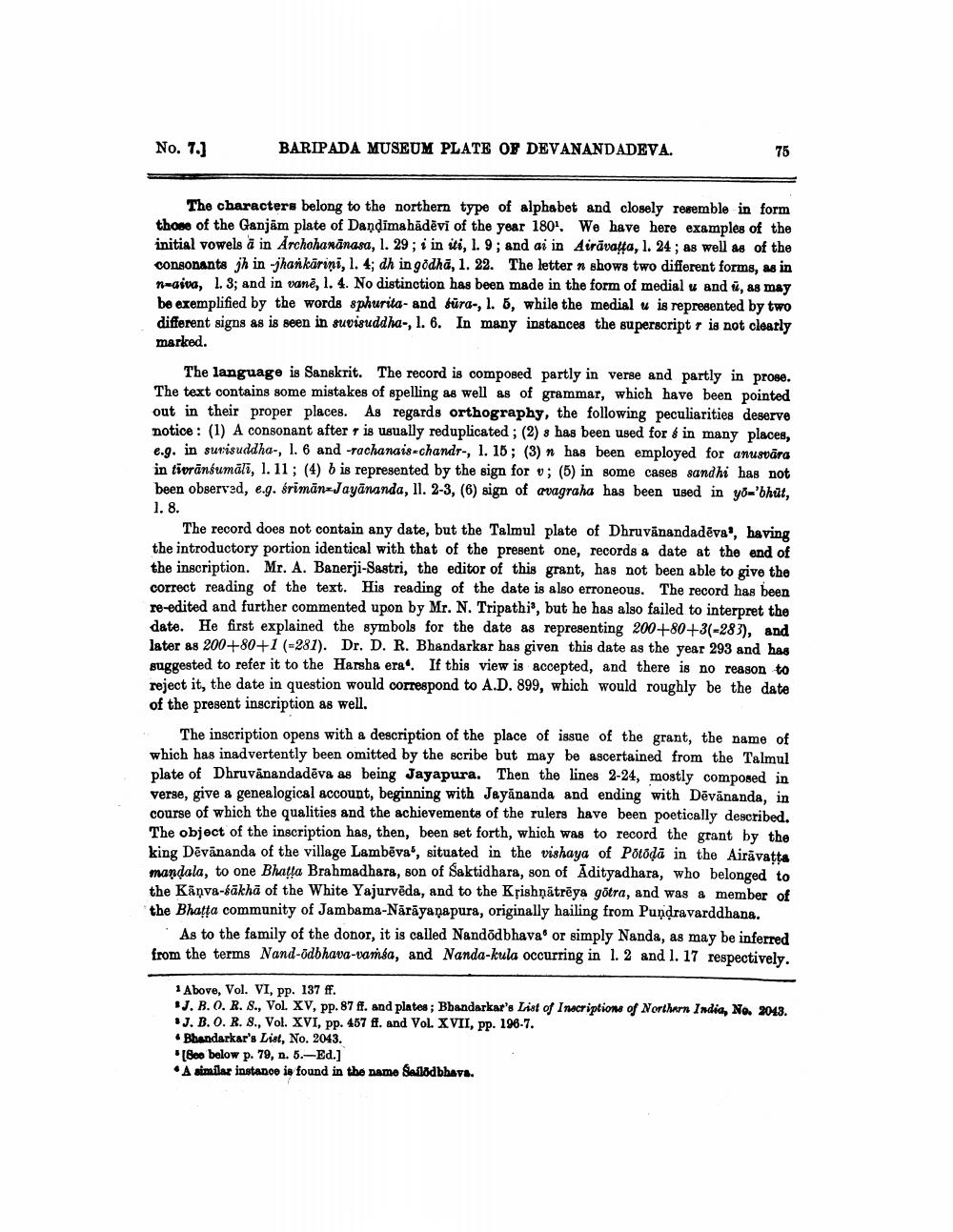________________
No. 7.)
BARIPADA MUSEUM PLATE OF DEVANANDADEVA.
The characters belong to the northern type of alphabet and closely resemble in form those of the Ganjam plate of Dandimahādēvi of the year 1804. We have here examples of the initial vowels a in Archohananasa, 1. 29; i in iti, 1. 9; and ai in Airāvaļa, 1. 24; as well as of the Consonants jh in jharkāriņi, 1. 4; dh in godhā, 1. 22. The letter n shows two different forms, as in n-aiva, 1. 3; and in vanē, l. 4. No distinction has been made in the form of medial u and i, 88 may be exemplified by the words sphurita- and tura-, l. 5, while the medial u is represented by two different signs as is seen in suvisuddha-, 1. 6. In many instances the superscript r is not clearly marked.
The language is Sanskrit. The record is composed partly in verse and partly in prose. The text contains some mistakes of spelling as well as of grammar, which have been pointed out in their proper places. As regards orthography, the following peculiarities deserve notice: (1) A consonant after 1 is usually reduplicated; (2) s has been used for & in many places, e.g. in surisuddha-, l. 6 and rachanais-chandr., 1. 15; (3) n has been employed for anusvāra in tivränsumāli, 1. 11; (4) b is represented by the sign for v; (6) in some cases sandhi has not been observed, e.g. Sriman Jayānanda, II. 2-3, (6) sign of avagraha has been used in you'bhut, 1. 8.
The record does not contain any date, but the Talmul plate of Dhruvanandadēva', having the introductory portion identical with that of the present one, records & date at the end of the inscription. Mr. A. Banerji-Sastri, the editor of this grant, has not been able to give the correct reading of the text. His reading of the date is also erroneous. The record has been re-edited and further commented upon by Mr. N. Tripathi', but he has also failed to interpret the date. He first explained the symbols for the date as representing 200-+-80+3(-283), and later as 200+80+1 (-281). Dr. D. R. Bhandarkar has given this date as the year 293 and has suggested to refer it to the Harsha era. If this view is accepted, and there is no reason to reject it, the date in question would correspond to A.D. 899, which would roughly be the date of the present inscription as well.
The inscription opens with a description of the place of issue of the grant, the name of which has inadvertently been omitted by the scribe but may be ascertained from the Talmul plate of Dhruvanandadēva as being Jayapura. Then the lines 2-24, mostly composed in verse, give a genealogical account, beginning with Jayānanda and ending with Dévånanda, in course of which the qualities and the achievements of the rulers have been poetically described. The object of the inscription has, then, been set forth, which was to record the grant by the king Dēvānanda of the village Lambēva', situated in the vishaya of Potodā in the Airāvatta mandala, to one Bhatta Brahmadhara, son of Saktidhara, son of Adityadhara, who belonged to the Känva-bākha of the White Yajurvēda, and to the Kšishnätröya götra, and was a member of the Bhata community of Jambama-Nārāyaṇapura, originally hailing from Pundravarddhana.
As to the family of the donor, it is called Nandodbhava or simply Nanda, as may be inferred from the terms Nand-odbhava-vamsa, and Nanda-kula occurring in 1.2 and 1. 17 respectively.
1 Above, Vol. VI, pp. 137 ff. J. B.O.R.S., Vol. XV, pp. 87 ff. and plates ; Bhandarkar's List of Inscriptions of Northern India, No. 2043.
J. B.O. R. 8., Vol. XVI, pp. 457 ff. and Vol. XVII, pp. 196-7. • Bhandarkar's List, No. 2043. [800 below p. 79, n. 5.-Ed.] A similar instance is found in the namo Sallodbhava.




